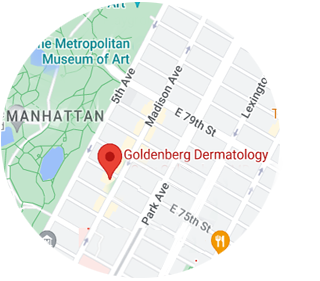Summer Tips for Preventing Sun Damage
Summer’s Here! Tips for Preventing Sun Damage to Skin –
Summer is finally here after three long months of coronavirus quarantine. And spending time outdoors has been determined to be much safer than being inside crowded restaurants, bars and gyms. But, as we spend more time outdoors we also risk more exposure to the cumulative effects of sun damage to our skin. Sun exposure can cause a wide variety of pigmentation, skin tone and texture problems including: freckles, age spots, and lines and wrinkles. Even more concerning, exposure to the sun’s ultraviolet (UV) radiation can contribute to the development of skin cancer.
In this article the dermatologists at Goldenberg Dermatology have compiled a list of 10 steps you can take to protect your skin, prevent sun damage and reduce the risk of skin cancer.
#1. Use sunscreen every day to prevent sun damage.
Apply sunscreen every time you are outdoors, even when it is cloudy or overcast. The sun’s UV rays can penetrate clouds! And, if you spend any time in a car or even sitting near a window indoors, you should also apply sunscreen. Most people don’t realize it, but the sun’s damaging UV rays can also penetrate glass.
#2. Apply at least an ounce of sunscreen.
An ounce of sunscreen is about enough to fill a shot glass. That sounds like a lot, but a thick layer of sunscreen is necessary to prevent the sun’s UV rays from reaching the skin.
Recent studies have shown that the amount of sunscreen typically contained in SPF makeup/foundation is not sufficient to prevent sun damage alone. A thicker quantity of an actual sunscreen is required to prevent both sunburn and sun damage.
#3. Apply sunscreen often.
Apply sunscreen about 15 to 30 minutes before venturing outside. Then reapply sunscreen every two hours. And, if you are swimming or sweating, reapply sunscreen every hour.
#4. Minimize intense sun exposure times.
If possible, try to limit the amount of time that you are in the direct sun between the hours of 10:00 AM and 4:00 PM. This is the period when the sun’s rays are the most intense, with the closer to noon being the most damaging time for the sun’s rays.
Keep an eye on your shadow. If your shadow is shorter than you are, then the sun’s rays are at their strongest point, and it is advisable to find some shade.
Also, limit your sun exposure around water and sand – both of which reflect the sun’s rays and increase your risk of getting sunburned.
#5. Don’t forget to protect your lips from sun damage.
Apply a lip balm or lipstick that contains an SPF of at least 30. Reapply every one to two hours, as well as immediately after eating or drinking.
#6. Protect your eyes from sun damage, too.
The sun can damage the eyes, as well. UV exposure substantially increases the risk of developing cataracts and/or macular degeneration later in life. And, the skin surrounding the eyes is particularly thin and sensitive – making it one of the most susceptible areas to lines and wrinkles caused by sun damage.
Make sure you wear sunglasses with 99% to 100% UV absorption lenses, to provide optimal sun protection for both the eyes and the surrounding sensitive skin.
#7. Wear a brimmed hat to prevent sun damage.
A large brimmed hat can also help protect the eyes, face, shoulders, back of the neck and chest from sun exposure!
#8. Wear protective clothing if possible.
You can’t cover up completely when you’re in the water – but a lightweight t-shirt over your bathing suit during peak sun times can help protect sensitive areas like the shoulders and chest (décolleté). Children, especially, should wear coverage when swimming if possible. (And babies younger than 6 months old should be kept completely covered and in the shade.)
When not swimming, whenever possible, wear a long-sleeved shirt and long pants, or a long dress or “cover up”. It may seem counter-intuitive, but dark clothing and tightly woven fabrics actually block more of the sun’s harmful rays than white or loosely woven fabrics.
For added protection, consider investing in clothing made with special sun-protective materials. Popular athletic wear company Patagonia®, for example, offers 40 – 50+ UPF sun protective clothing that blocks at least 97.5% of the sun’s UV rays.
#9. Avoid the sun when taking certain medications.
Many medications may make you more sensitive to the sun, increasing the risk of sunburn and UV skin damage, including: some antibiotics, anti-inflammatory medications, antifungals, blood pressure prescriptions, and chemotherapy. Read the instructions with any medications you are taking, or consult with your pharmacist or physician, before venturing out into the sun.
#10. Wear the right sunscreen!
We’ve saved the most important rule for last: always choose the right kind of sunscreen!
All sunscreens are NOT created equal. Be sure to apply a broad spectrum sunscreen that protects against both UVA and UVB radiation, with an SPF of 30 or higher.
And remember, just because a sunscreen keeps you from getting sunburned, it doesn’t necessarily mean it will protect against skin cancer. If you do not have a broad spectrum sunscreen with an SPF of 30 or more you are still exposed to dangerous rays that can cause skin cancer – even without a sunburn.
Additionally, a sunscreen should be non-comedogenic – meaning it will not clog pores. And the best sunscreens will also facilitate skin repair on a cellular level – to fight the damage of the UVs rays.
At Goldenberg Dermatology we offer two of the highest quality sunscreens:
Goldenberg Dermatology SPF45: our own dermatologist developed sunscreen that is non-comedogenic and offers both a physical and chemical sun blocker, for ultimate skin protection.
ISDIN Eryfotona Actinica: a broad spectrum sunscreen with DNA Repairsomes™ and antioxidants that prevents actinic damage and helps skin repair visible signs of sun damage and aging.
Sun Damage Treatments – NYC
Preventing sun damage by taking these steps can help you avoid unwanted sun spots, age spots, dark spots and freckles. Avoiding the sun’s damaging UV rays can also help delay signs of aging from developing, including lines and wrinkles. Contact Goldenberg Dermatology in NYC for the best, most-advanced sunscreens and sun protection products.
And, if your skin is already showing signs of sun damage – such as pigmentation, lines or wrinkles – schedule a consultation at Goldenberg Dermatology. We offer many treatments that can reverse the effects of sun damage, including: Cutera ExcelV Laser, MIXto Fractional CO2 Laser, and state-of-the-art Eclipse PRP. These treatments can minimize dark spots, and resurface lines and wrinkles – for clearer, smoother, younger-looking skin!











